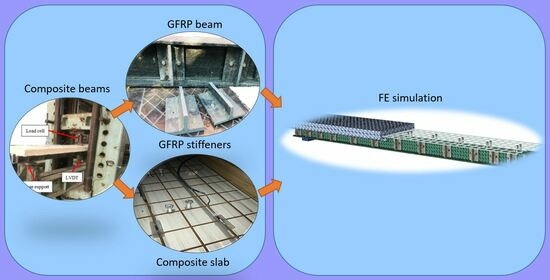Flexural Behavior of Pultruded GFRP–Concrete Composite Beams Strengthened with GFRP Stiffeners
Abstract
1. Introduction
2. Experimental Work
2.1. Details of the Tested Specimens
2.2. Materials
2.3. Test Setup and Instrumentations
3. Results and Discussions
3.1. Load–Deformation Relationships
3.2. Strain Measurements
3.3. Modes of Failure
4. Numerical Modeling
4.1. Selection of Elements
4.2. Material Modeling
4.3. Model Verifications
5. Conclusions
- The strengthening of the shear webs of GFRP I-beams with GFRP T-section stiffeners resulted in an enhancement in the flexural and shear strength.
- The effect of the concrete compressive strength was vital, where the failure loads increased by 79.9% and 77.1% when the HSC was used instead of NSC for the cases of bolt–epoxy and bolts only, respectively.
- The composite beams that were reinforced using a combination of bolts and epoxy demonstrated significantly greater ultimate failure loads compared to the GFRP beams that were solely reinforced with bolts. The failure loads in the case of bolt–epoxy connection for the stiffeners were 8.2% and 10.0% higher than those in the case of bolts only when the concrete compressive strengths were 20.1 MPa and 52.3 MPa, respectively. The epoxy adhesive used in conjunction with mechanical connectors, specifically bolts, resulted in sufficient composite action and delayed shear failure within the web of the GFRP beam.
- For the specimens with bolt–epoxy connection, strain levels in the concrete slabs were consistently higher than the other specimens with bolts alone at the same loading level. The concrete slabs integrated with HSC registered strain levels that were 20.0% and 21.8% greater for bolt–epoxy and bolt-only connections, respectively, when compared to those using normal-strength concrete (NSC). This discrepancy can likely be credited to the enhanced composite interaction between the concrete slabs and the GFRP I-beams.
- Overall, the use of GFRP I-beams in conjunction with concrete warrants additional research and examination in order to establish a rational basis for the effective utilization of concrete and GFRP composites, and to investigate additional parameters.
Author Contributions
Funding
Data Availability Statement
Conflicts of Interest
References
- Zhang, S.; Caprani, C. Mechanical properties of pultruded GFRP at intermediate strain rates. Compos. Struct. 2021, 278, 114699. [Google Scholar] [CrossRef]
- Liu, T.; Feng, P.; Lu, X.; Yang, J.; Wu, Y. Flexural behavior of novel hybrid multicell GFRP-concrete beam. Compos. Struct. 2020, 250, 112606. [Google Scholar] [CrossRef]
- Mahmood, E.M.; Allawi, A.A.; El-Zohairy, A. Flexural Performance of Encased Pultruded GFRP I-Beam with High Strength Concrete under Static Loading. Materials 2022, 15, 4519. [Google Scholar] [CrossRef] [PubMed]
- Vedernikov, A.; Gemi, L.; Madenci, E.; Özkılıç, Y.O.; Yazman, Ş.; Gusev, S.; Sulimov, A.; Bondareva, J.; Evlashin, S.; Konev, S.; et al. Effects of high pulling speeds on mechanical properties and morphology of pultruded GFRP composite flat laminates. Compos. Struct. 2022, 301, 116216. [Google Scholar] [CrossRef]
- Canning, L.; Hollaway, L.; Thorne, A. An investigation of the composite action of an FRP/concrete prismatic beam. Constr. Build. Mater. 1999, 13, 417–426. [Google Scholar] [CrossRef]
- Deskovic, N.; Meier, U.; Triantafillou, T.C. Innovative design of FRP combined with concrete: Long-term behavior. J. Struct. Eng. 1995, 121, 1079–1089. [Google Scholar] [CrossRef]
- Evbuomwan, N. Behaviour of FRP prismatic sections in composite action with concrete. In Proceedings of the International Conference on Fibre Reinforced Composites No7, Newcastle upon Tyne, UK, 15–17 April 1998; pp. 53–62. [Google Scholar]
- Liu, T.; Liu, X.; Feng, P. A comprehensive review on mechanical properties of pultruded FRP composites subjected to long-term environmental effects. Compos. Part B Eng. 2020, 191, 107958. [Google Scholar] [CrossRef]
- Zou, X.; Lin, H.; Feng, P.; Bao, Y.; Wang, J. A review on FRP-concrete hybrid sections for bridge applications. Compos. Struct. 2021, 262, 113336. [Google Scholar] [CrossRef]
- Ali, S.I.; Allawi, A.A. Effect of Web Stiffeners on The Flexural Behavior of Composite GFRP-Concrete Beam Under Impact Load. J. Eng. 2021, 27, 76–92. [Google Scholar] [CrossRef]
- Allawi, A.A.; Ali, S.I. Flexural behavior of composite GFRP pultruded I-section beams under static and impact loading. Civ. Eng. J. 2020, 6, 143–2158. [Google Scholar] [CrossRef]
- Gemi, L.; Madenci, E.; Özkılıç, Y.O. Experimental, analytical and numerical investigation of pultruded GFRP composite beams infilled with hybrid FRP reinforced concrete. Eng. Struct. 2021, 244, 112790. [Google Scholar] [CrossRef]
- Hadi, M.N.S.; Youssef, J. Experimental investigation of GFRP-reinforced and GFRP-encased square concrete specimens under axial and eccentric load, and four-point bending test. Compos. Constr. 2016, 20, 04016020. [Google Scholar] [CrossRef]
- Evbuomwan, N.F.O. Flexural behaviour of GFRP prismatic beams in composite action with concrete. In Research and Applications in Structural Engineering, Mechanics and Computation; Taylor and Francis Group: London, UK, 2013; Chapter 267. [Google Scholar] [CrossRef]
- Hadi, M.N.S.; Yuan, J.S. Experimental investigation of composite beams reinforced with GFRP I-beam and steel bars. Constr. Build. Mater. 2017, 144, 462–474. [Google Scholar] [CrossRef]
- Xue, W.; Zhang, S. Experimental study on shear connectors of FRP concrete composite beams. J. Highw. Transp. Res. Dev. 2014, 10, 207–210. [Google Scholar]
- Neagoe, C.A.; Gil, L.; Pérez, M.A. Experimental study of GFRP-concrete hybrid beams with low degree of shear connection. Constr. Build. Mater. 2015, 101, 141–151. [Google Scholar] [CrossRef]
- Correia, J.R.; Gomes, M.M.; Pires, J.M.; Branco, F.A. Mechanical behaviour of pultruded glass fibre reinforced polymer composites at elevated temperature: Experiments and model assessment. Compos. Struct. 2013, 98, 303–313. [Google Scholar] [CrossRef]
- Nkosi, G.M. A Reliability Based Comparison of Eurocode 3 & SANS 10162-1. Master’s Thesis, University of Johannesburg, Johannesburg, South Africa, 2020. [Google Scholar]
- ASTM D695; Standard Test Method for Compressive Properties of Rigid Plastics. ASTM International: West Conshohocken, PA, USA, 2015.
- ISO 527-1; Plastics—Determination of Tensile Properties—Part 1: General Principles. ISO: Geneva, Switzerland, 2019.
- Karayannis, C.G.; Kosmidou, P.-M.K.; Chalioris, C.E. Reinforced Concrete Beams with Carbon-Fiber-Reinforced Polymer Bars—Experimental Study. Fibers 2018, 6, 99. [Google Scholar] [CrossRef]
- BS 1881-124:2015; Testing Concrete. Methods for Analysis of Hardened Concrete. British Standards Institution: London, UK, 2015.
- Abaqus. Abaqus 6.2: Computer Software for Finite Element Analysis; Dassault Systems Simulia: Johnston, RI, USA, 2019. [Google Scholar]
- Ibrahim, T.H.; Allawi, A.A.; El-Zohairy, A. Experimental and FE analysis of composite RC beams with encased pultruded GFRP I-beam under static loads. Adv. Struct. Eng. 2023, 26, 516–532. [Google Scholar] [CrossRef]
- Hafezolghorani, M.; Hejazi, F.; Vaghei, R.; Jaafar, M.S.B.; Karimzade, K. Simplified Damage Plasticity Model for Concrete. Struct. Eng. Int. 2018, 27, 68–78. [Google Scholar] [CrossRef]
- Eurocode 2: Design of Concrete Structures-Part 1-1: General Rules and Rules for Buildings; British Standards Institution: London, UK, 2004.
- Kent, D.C.; Park, R. Flexural members with confined concrete. J. Struct. Div. 1971, 97, 1969–1990. [Google Scholar] [CrossRef]
- Park, R. Reinforced Concrete Structures; John Wiley & Sons: New York, NY, USA, 1975. [Google Scholar]
- Hashin, Z. Fatigue failure criteria for unidirectional fiber composites. J. Appl. Mech. 1980, 47, 329–334. [Google Scholar] [CrossRef]
- Barbero, E.; Cosso, F.; Roman, R.; Weadon, T. Determination of material parameters for Abaqus progressive damage analysis of E-glass epoxy laminates. Compos. Part B Eng. 2013, 46, 211–220. [Google Scholar] [CrossRef]
- Barbero, E.J. Finite Element Analysis of Composite Materials Using Abaqus®; CRC Press: Boca Raton, FL, USA, 2023. [Google Scholar]
- Ibrahim, T.H.; Allawi, A.A.; El-Zohairy, A. Impact Behavior of Composite Reinforced Concrete Beams with Pultruded I-GFRP Beam. Materials 2022, 15, 441. [Google Scholar] [CrossRef] [PubMed]
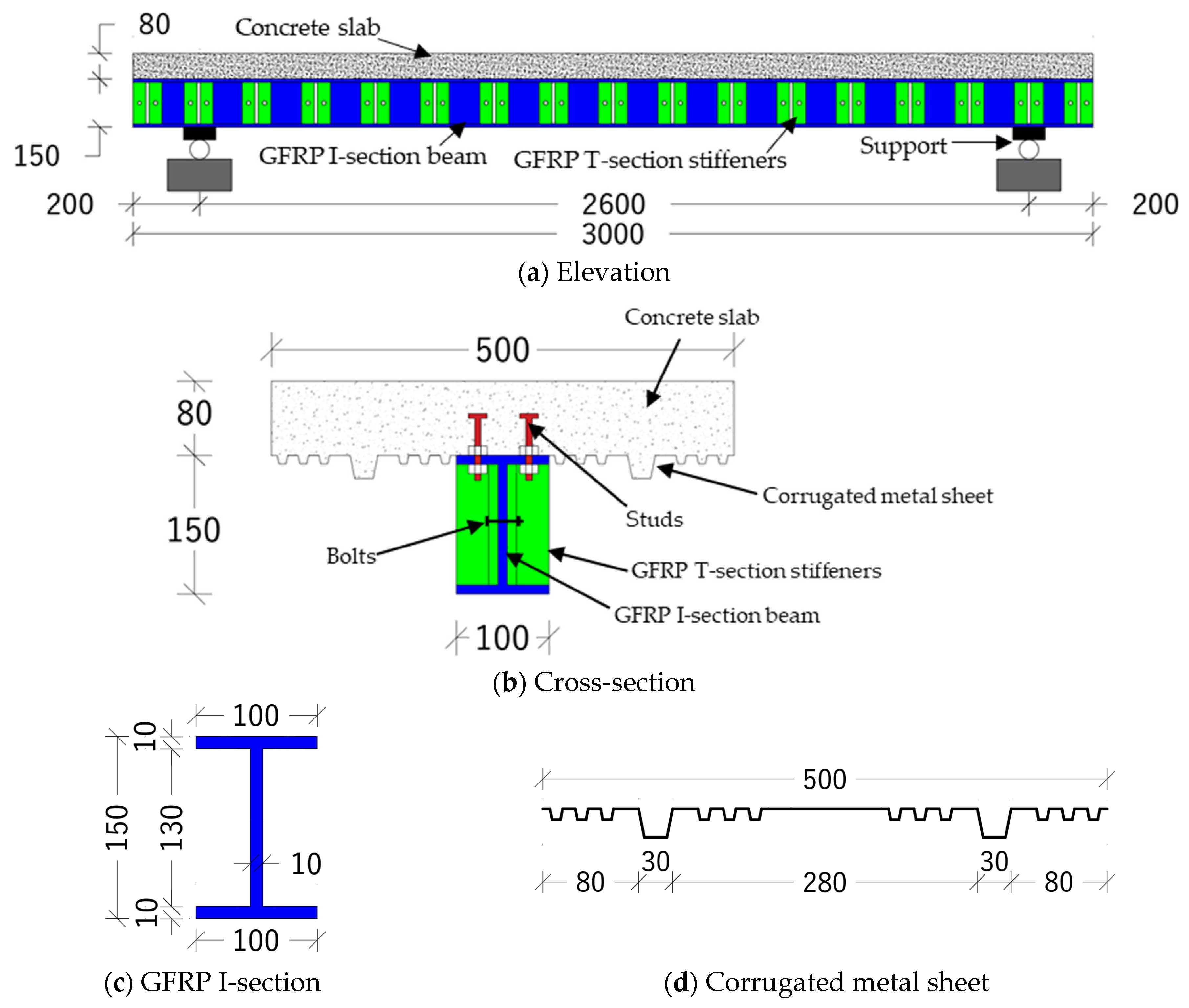



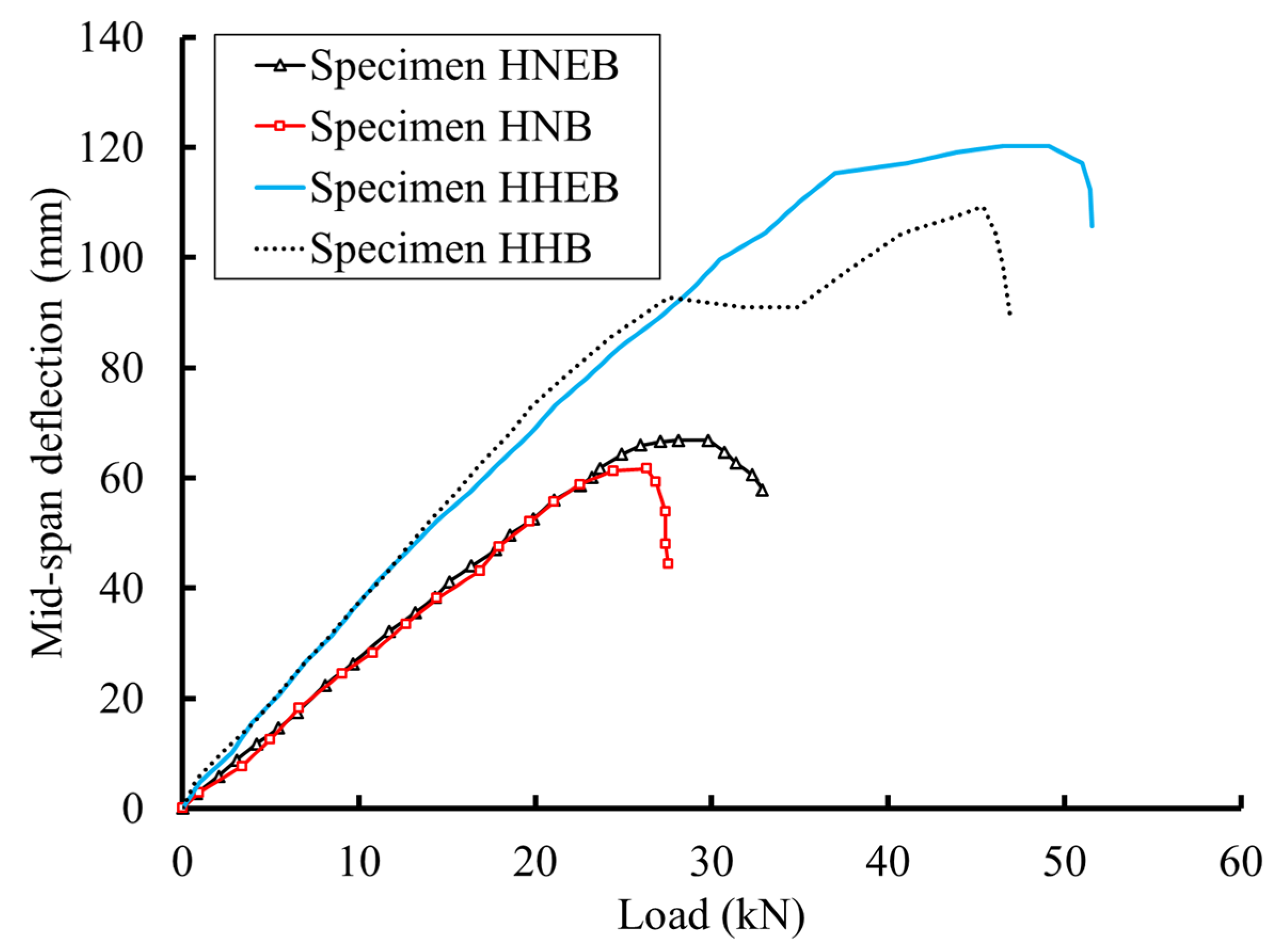
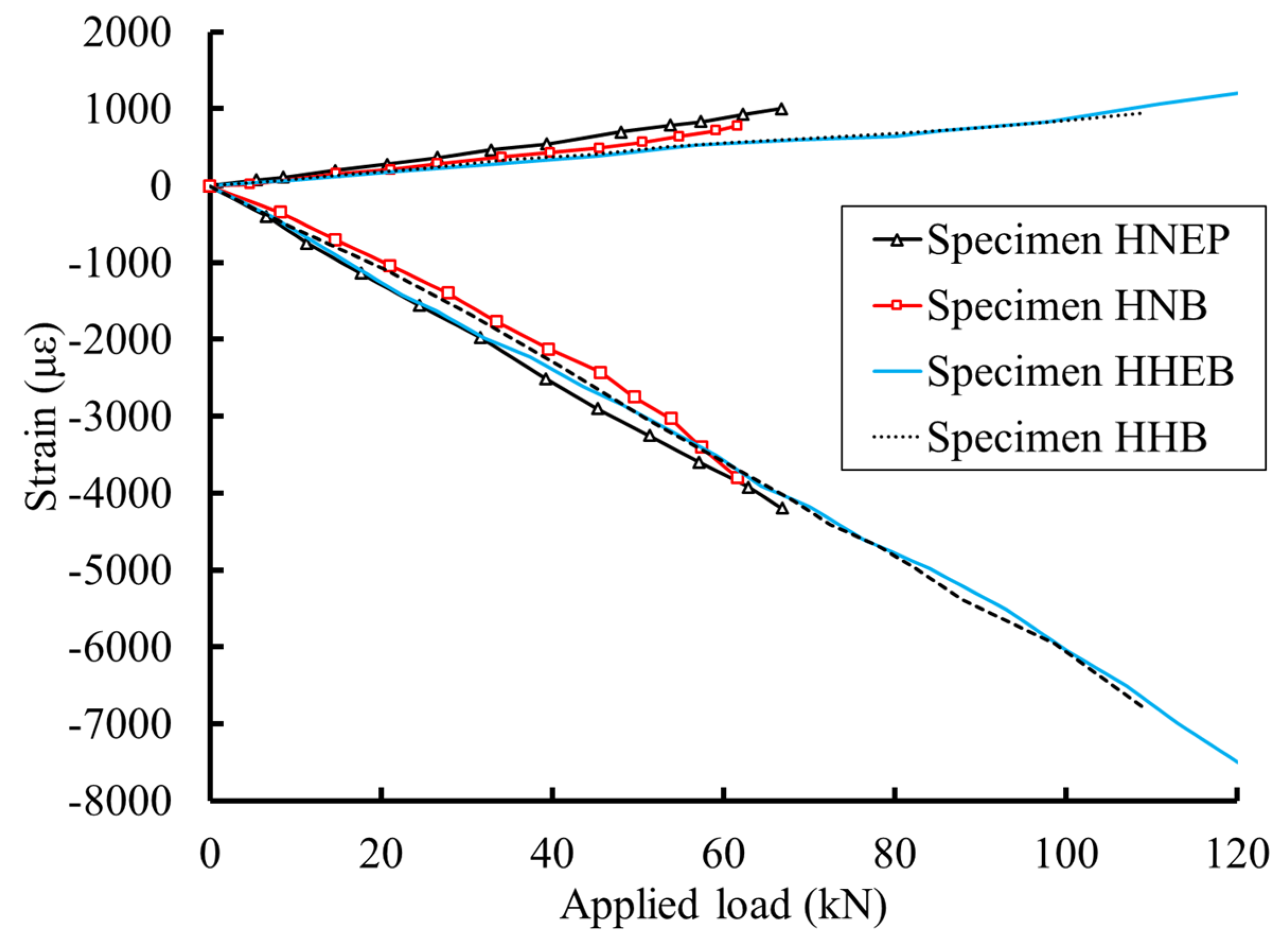


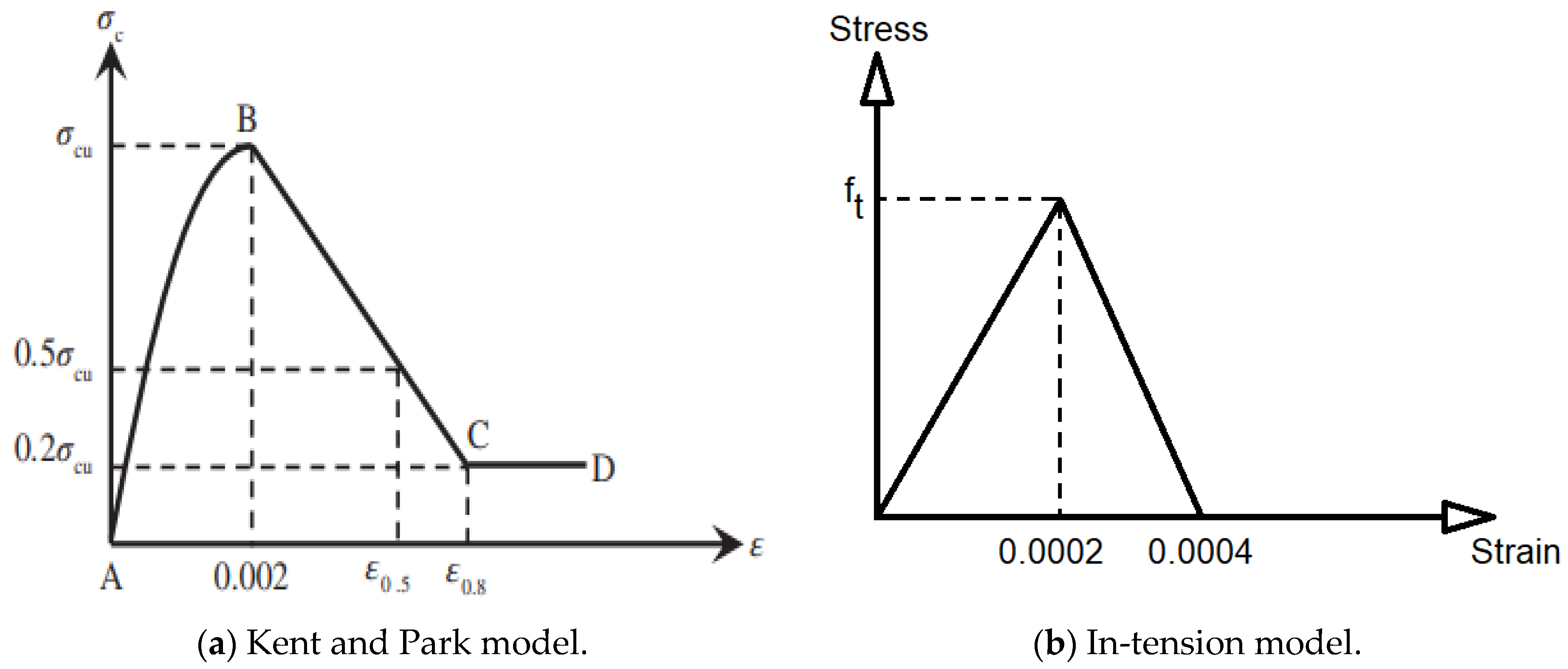
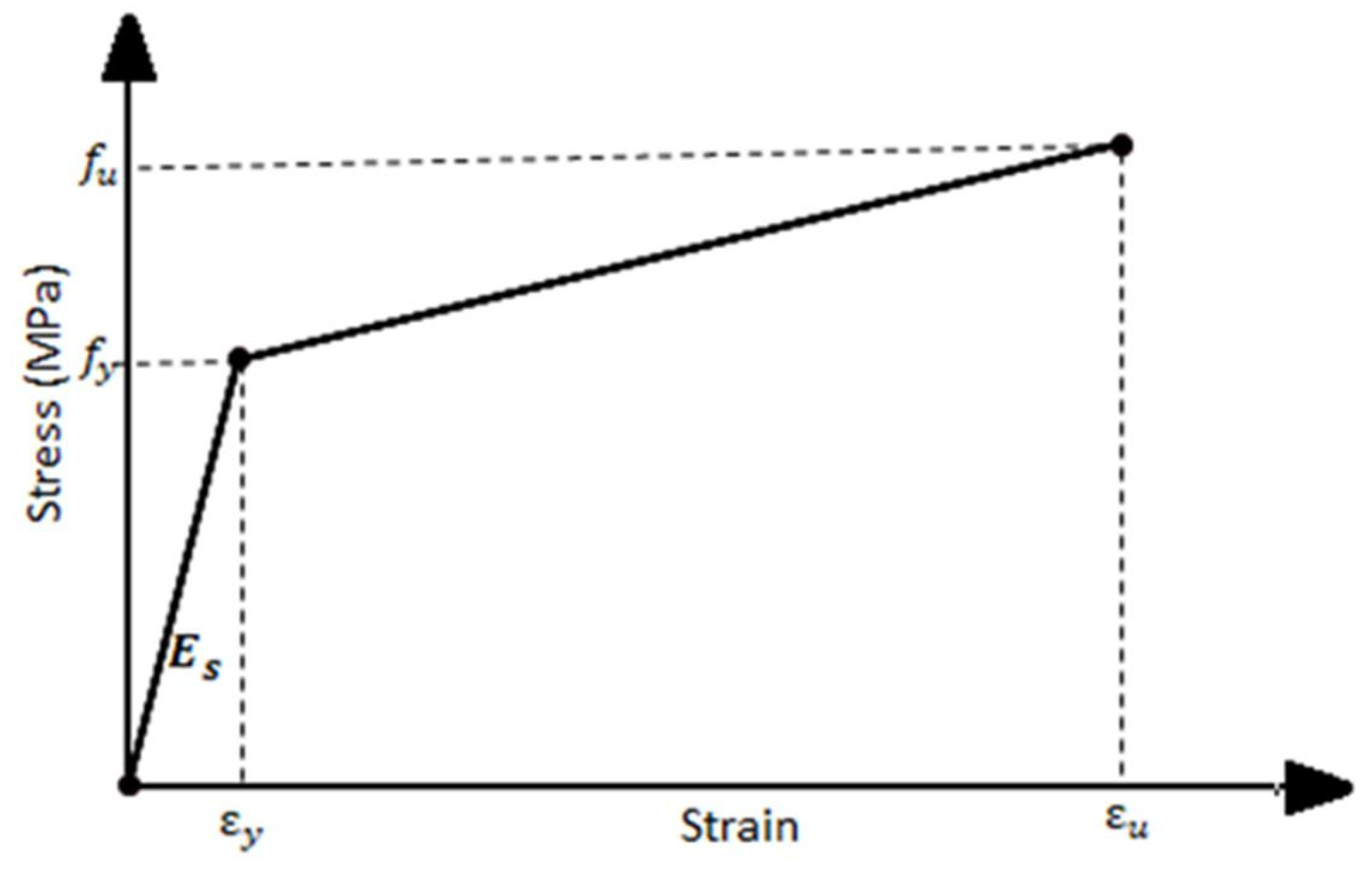
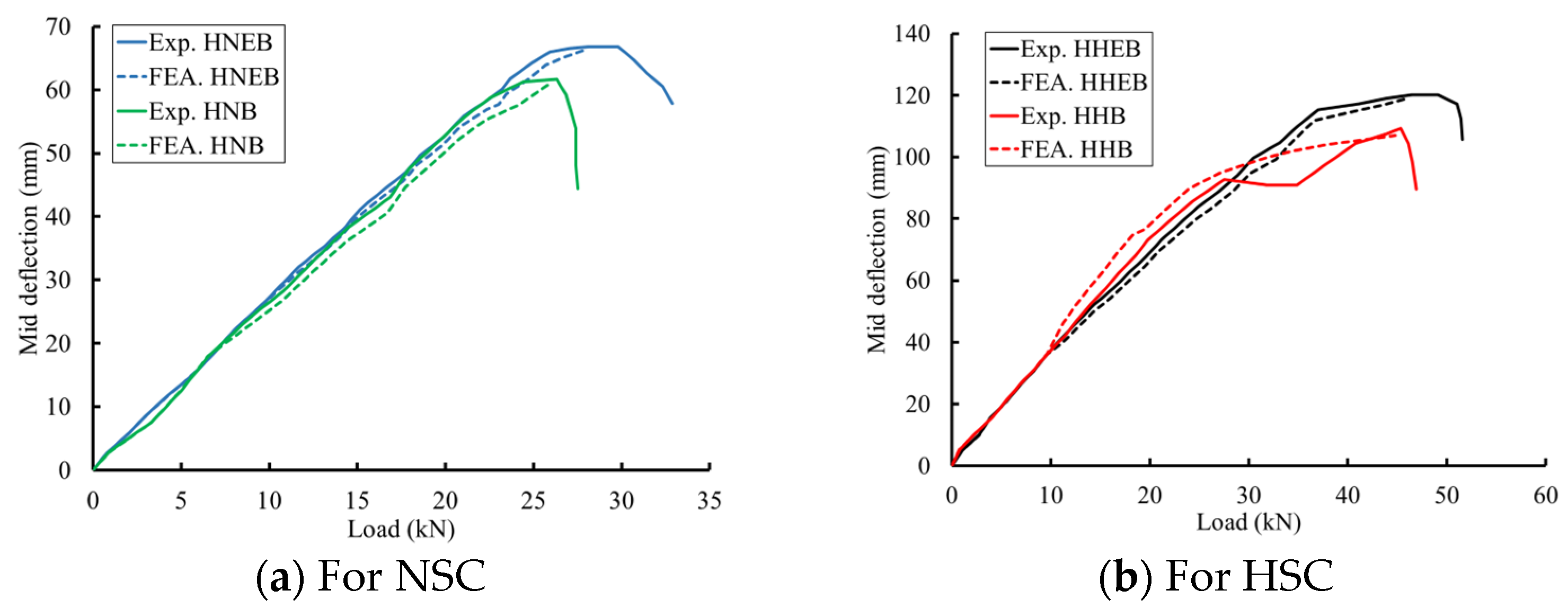
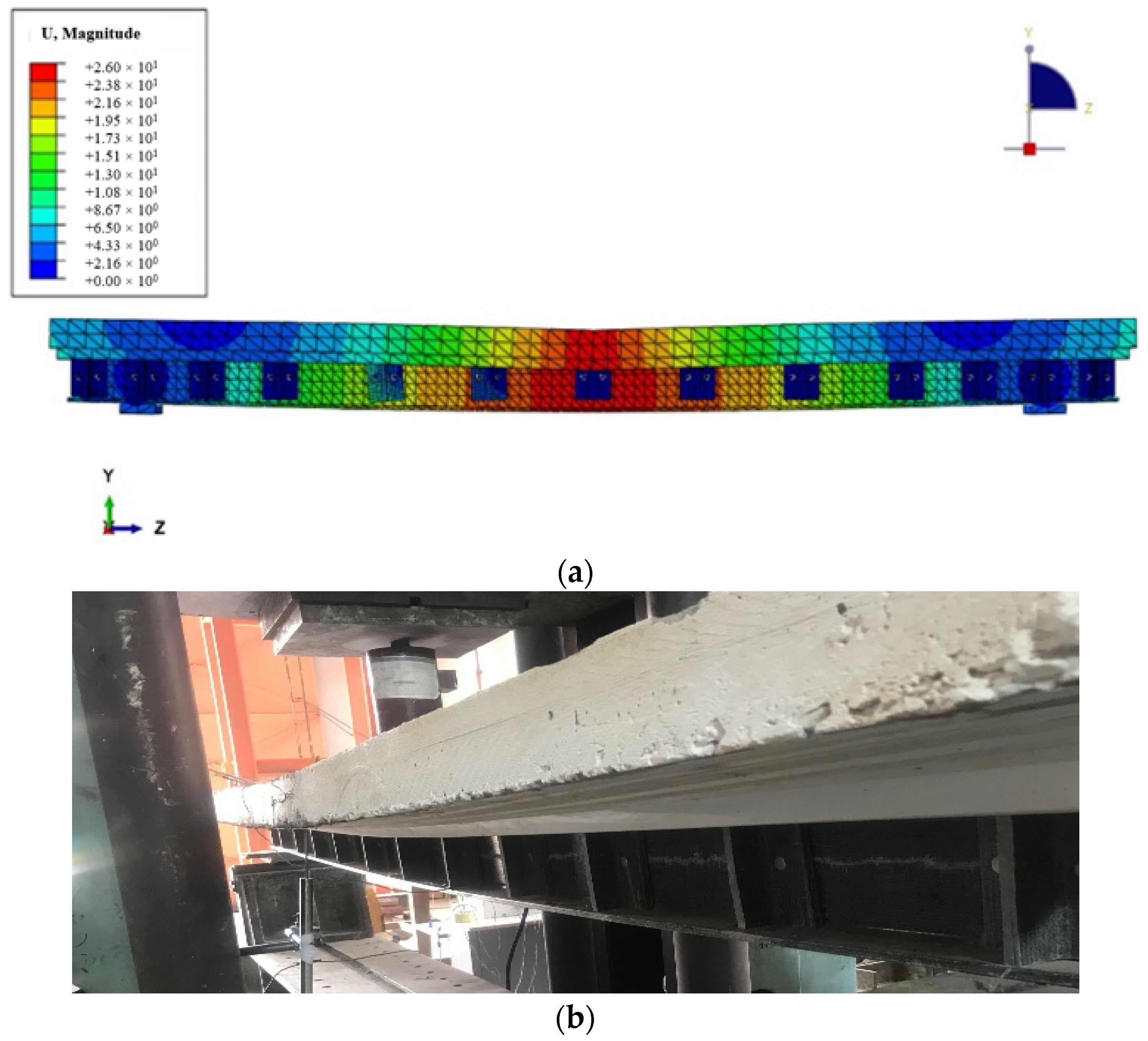
| Specimen | Stiffeners | Concrete * | Length (mm) | Stud Height × Diameter (mm) | Stud Spacing (mm) | Corrugated Sheets Thickness (mm) |
|---|---|---|---|---|---|---|
| HNEB | Bolt–Epoxy | NSC | 2600 | 75 × 12 | 260 | 0.5 |
| HNB | Bolt only | NSC | 2600 | 75 × 12 | 260 | 0.5 |
| HHEB | Bolt–Epoxy | HSC | 2600 | 75 × 12 | 260 | 0.5 |
| HHB | Bolt only | HSC | 2600 | 75 × 12 | 260 | 0.5 |
| Mechanical Properties | Value | Geometrical Properties | Value |
|---|---|---|---|
| Transverse Compressive Strength (MPa) | 118.3 | Area (mm2) | 3300 |
| Longitudinal Compressive Strength (MPa) | 326.14 | Perimeter (mm) | 680 |
| Longitudinal Tensile Strength (MPa) | 347.5 | Moment of inertia (mm4) | 11,647,500 |
| Longitudinal Elastic Modulus (MPa) | 27,100 | Mass (Kg/m) | 5.94 |
| Transverse Elastic Modules (MPa) | 6800 | Web and flange thickness (mm) | 10 |
| Specimen | Failure Load (kN) | Mid-Span Deflection (mm) | Strain at Failure (με) | Mode of Failure |
|---|---|---|---|---|
| HNEB | 66.8 | 28.1 | 1000 | Web shear |
| HNB | 61.7 | 26.3 | 780 | Web shear |
| HHEB | 120.2 | 50.2 | 1200 | Web shear |
| HHB | 109.3 | 44.7 | 950 | Web shear |
| Definition | Value | ||
|---|---|---|---|
| Engineering Elastic Constants | Longitudinal Elastic Modulus (Ez) | 27.1 GPa | |
| Transverse Elastic Modulus (Ex = Ey) | 6.8 GPa | ||
| Transverse Shear Elastic Modulus (Gxy) | 17.5 GPa | ||
| In-Plane Shear Elastic Modulus (Gzx = Gzy) | 2.7 GPa | ||
| Major Poisson’s Ratio (υzx = υzy) | 0.23 | ||
| Minor Poisson’s Ratio (υxy) | 0.1 | ||
| Strength Values | Tensile Strength | Longitudinal | 347.5 MPa |
| Transverse | 50 MPa | ||
| Compressive Strength | Longitudinal | 326.1 MPa | |
| Transverse | 118.3 MPa | ||
| Shear Strength | Longitudinal | 8.04 MPa | |
| Transverse | 104.23 MPa | ||
| Damage Evolution | Tensile Fracture Energy | Longitudinal | 18.3 N/mm |
| Transverse | 5 N/mm | ||
| Compressive Fracture Energy | Longitudinal | 5.8 N/mm | |
| Transverse | 5.5 N/mm | ||
| Specimen | Experimental | FE | EXP./FE (%) * | EXP./FE (%) ** | ||
|---|---|---|---|---|---|---|
| Ultimate Failure Load (kN) | Maximum Deflection (mm) | Ultimate Failure Load (kN) | Maximum Deflection (mm) | |||
| HNEB | 66.82 | 28.10 | 66.22 | 27.84 | 0.9 | 0.92 |
| HNB | 61.73 | 26.32 | 61.19 | 26.02 | 0.89 | 1.16 |
| HHEB | 120.20 | 50.22 | 119.07 | 49.68 | 0.95 | 1.08 |
| HHB | 109.32 | 44.68 | 108.10 | 44.12 | 1.13 | 1.27 |
| Specimen | Strains at the Ultimate Failure Load (με) | % Change | ||||
|---|---|---|---|---|---|---|
| Experimental | FE | |||||
| Tension | Compression | Tension | Compression | Tension | Compression | |
| HNEB | 4197 | 1202 | 4266 | 1247 | +1.64 | +3.74 |
| HNB | 3795 | 1006 | 3945 | 1028 | +3.95 | +2.18 |
| HHEB | 7502 | 781 | 7617 | 802 | +1.53 | +2.68 |
| HHB | 6799 | 953 | 6823 | 984 | +0.35 | +3.25 |
Disclaimer/Publisher’s Note: The statements, opinions and data contained in all publications are solely those of the individual author(s) and contributor(s) and not of MDPI and/or the editor(s). MDPI and/or the editor(s) disclaim responsibility for any injury to people or property resulting from any ideas, methods, instructions or products referred to in the content. |
© 2024 by the authors. Licensee MDPI, Basel, Switzerland. This article is an open access article distributed under the terms and conditions of the Creative Commons Attribution (CC BY) license (https://creativecommons.org/licenses/by/4.0/).
Share and Cite
Ali, M.I.; Allawi, A.A.; El-Zohairy, A. Flexural Behavior of Pultruded GFRP–Concrete Composite Beams Strengthened with GFRP Stiffeners. Fibers 2024, 12, 7. https://doi.org/10.3390/fib12010007
Ali MI, Allawi AA, El-Zohairy A. Flexural Behavior of Pultruded GFRP–Concrete Composite Beams Strengthened with GFRP Stiffeners. Fibers. 2024; 12(1):7. https://doi.org/10.3390/fib12010007
Chicago/Turabian StyleAli, Muataz I., Abbas A. Allawi, and Ayman El-Zohairy. 2024. "Flexural Behavior of Pultruded GFRP–Concrete Composite Beams Strengthened with GFRP Stiffeners" Fibers 12, no. 1: 7. https://doi.org/10.3390/fib12010007
APA StyleAli, M. I., Allawi, A. A., & El-Zohairy, A. (2024). Flexural Behavior of Pultruded GFRP–Concrete Composite Beams Strengthened with GFRP Stiffeners. Fibers, 12(1), 7. https://doi.org/10.3390/fib12010007








